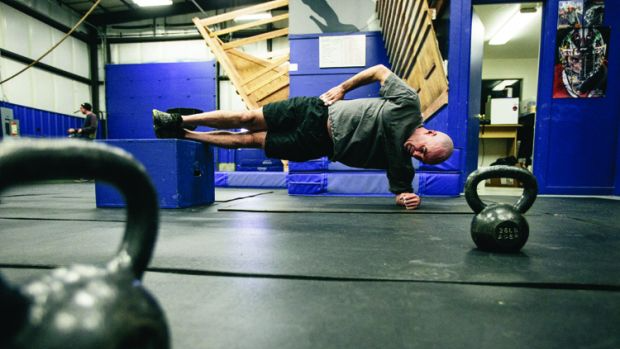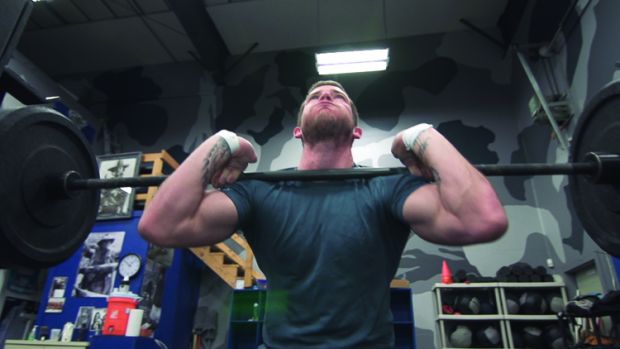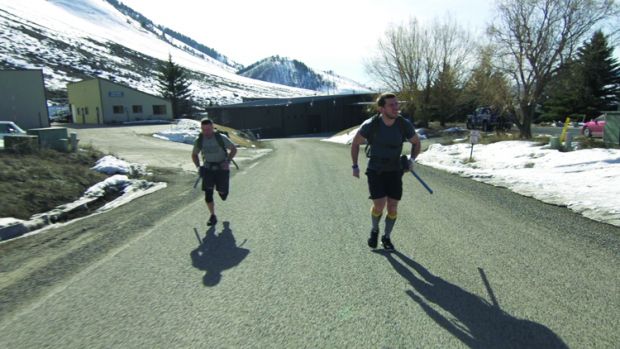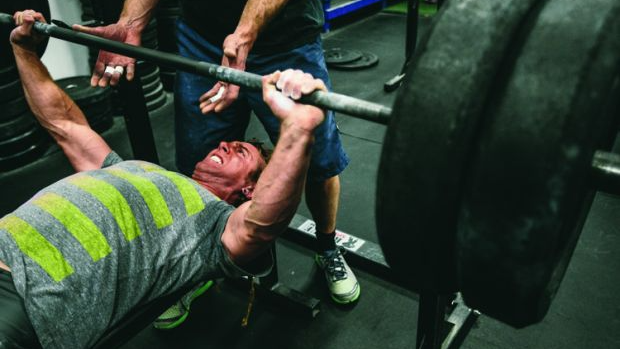MF takes on Mountain Athlete
At controversial conditioning centre Mountain Athlete, they say performing well outdoors is all about what you do indoors
It’s 5am, it’s dark and it’s chilly. America is asleep but I’m standing outside a warehouse on a dusty little estate that looks out over a sprawling plain just outside of the ski resort of Jackson Hole in Wyoming.
A light flickers on inside. I scrub at the frost on the window that’s obscuring my view and see a short, squat man moving around purposefully. He’s positioning squat racks, slapping down crash mats and dropping chains at various points across the rubberised floor. I spy a variety of climbing walls as well as an Astroturf running track and a sturdy-looking pull-up rig, while one wall is covered with whiteboards listing all manner of workouts. The place stinks of hard work.
The man stops moving kit around. He looks up as if he’s picked up a scent and turns his head in my direction. We make eye contact. He looks focused, almost angry. I can tell this is a guy who won’t take any shit. He opens the door, allowing the familiar gym smell of sweat, chalk and bleach to fill my nostrils. He favours me with an unnerving stare. This is Rob Shaul, the 46-year-old founder of mountain sport strength and conditioning facility Mountain Athlete, and right now I’m quite scared of him.
He pumps my extended hand in a meaty mitt. ‘You ready to do some work, Nick?’ he barks at me. I maintain eye contact with him while I answer in the affirmative. I sense Shaul is not a man who responds well to any sign of fear.
Strong foundations
Mountain Athlete was set up in February 2007 when Shaul, a strength and conditioning coach, former coastguard and self-confessed gym fanatic, realised that winter sports athletes were fundamentally weak. ‘If you’re not strong, you can’t perform at your peak,’ he tells me as we walk into the gym. ‘So our aim here is to help climbers, skiers and snowboarders build that up as well as several other key areas of base fitness – work capacity, stamina, endurance and durability. We believe in purposeful, planned, periodised and progressed training. Improvement in any endeavour happens for a reason, so nothing here is accidental or unnecessary.’

Shaul works with athletes during their off-season in a bid to get them ready to go hard on the slopes or walls as soon as they’re open. ‘Everything we do is geared towards how they perform outside. Once we’ve got our athletes’ base fitness to a good level,
we also help build sport-specific strength.’ You won’t find casual gym-goers here; it’s a private facility for serious athletes, whether professional or amateur. They do, however, offer online programmes that are available to buy from mountainathlete.com.
Today, however, Shaul wants to introduce me to another aspect of the centre’s operations. ‘We also have a programme called Military Athlete, which we set up in 2009,’ he says, loading up two squat racks with Olympic bars. ‘It focuses on giving servicemen the functional strength, stamina, durability and high work capacity they need to perform at their peak on the battlefield.’ So ultimately it’s about increasing their chances of survival during warfare and extending their careers. You can see why Shaul is respected in military circles.
Get the Coach Newsletter
Sign up for workout ideas, training advice, reviews of the latest gear and more.
‘This morning you and I are going to do a test I’ve devised to determine what kind of shape a soldier is in: max rep bodyweight front squats, max rep bodyweight bench presses, max rep pull-ups, a 5km race and a shooting range drill. The standards our athletes have to hit are ten reps on the front squats, bench and pulls and they have to come in under 36 minutes on the run.’
Testing, testing
Although Shaul isn’t a lab-coat-and-specs kind of guy, he does take a research-driven approach, testing all his training ideas on local athletes he calls his ‘lab rats’. Today, I’m a lab rat. I doubt I’ll get a nice piece of cheese at the end.
Shaul goes first with the front squats. He hammers out 21, ass to grass with a back that’s ramrod straight. ‘I love front squats,’ he says, once he’s dumped the bar back on the rack. ‘Because you have to balance the bar, it forces you to perform each rep perfectly, which recruits more muscle than the back squat so you get stronger.’

My turn. I manage a paltry nine. I don’t think Shaul is impressed. Fortunately, we’re moving on to upper-body moves where I’m pretty sure I can hold my own.
‘On duty, soldiers will have to push and pull heavy things so benching and pull-ups will help them cope with those demands,’ Shaul explains as he slides under the bar and bashes out 18 bench presses. I do better than with the front squats, but on my 11th rep I start to rely on my stronger left side too much, which starts to throw me off-balance. ‘Push your shoulders into the bench,’ Shaul tells me. ‘It’ll even you out.’ Using his technique I get through another three before my chest gives out. The strength section of the test ends with pull-ups – in which we both max out at 21. Better.
Weighed down
‘Military personnel have to carry heavy packs and a weapon for long distances,’ says Shaul as we step outside into the now bright morning light. ‘We’re going to do a 5km run while carrying a tightly strapped 20kg backpack and a 5kg sledgehammer [roughly the same weight as a rifle] as a test of how fit you are.’ On the flat this would be tough, but the hilly route Shaul wants me to run is going to make it a lung-scorching, leg-blazing mess. Oh, and he wants to race me.
We’re off and I hare ahead, trying to use my longer levers to build up a good lead. But a vicious combination of weight, altitude – we’re at 2,000m – and the tight backpack strap stopping me from getting enough oxygen into my lungs, forces me to slow to power-walking speed. Within 500m Shaul catches me, then pulls away.
Eventually my system adapts and I manage to control my breathing, establish a good posture and start to reel him in. At the end of the first 1km lap, I creep past him and manage to stay ahead, finishing the run in 29min 9sec with Shaul one minute behind me.
Fire away
After some lunch and a spot of foam rolling, we jump in Shaul’s truck and drive to the nearest gun range for a range fitness stress test. ‘We’re going to fire five shots at a target 70m away from four different positions – standing, on one knee, sitting and lying,’ Shaul says. ‘You’ll have 2½ minutes to get your shots off from each position. Before getting into each one you’ll do a 20m shuttle run to get your heart rate up, replicating the conditions you might face when you engage with an enemy in combat. And you’ll be wearing body armour to add extra weight.’
In this discipline I offer him no competition at all for two reasons. First, I’m terrified of guns – especially the huge, demonic-looking semi-automatic AR-15s we’re using – and second, I can’t get my heart rate under control enough to hit the target more than a couple of times from each position. How the hell would you do this in a warzone with targets that fire back?

We finish and Shaul evaluates our scores. ‘You did OK for a someone who’s never shot guns before,’ he says. I think that’s praise, although I still can’t read him well enough to be entirely sure. ‘Come back the day after tomorrow and I’ll stick you in a session with some of my climbing lab rats.’
Local love
The day before my first session with Shaul, I’d searched Jackson Hole for athletes who’d worked with him to find out how Mountain Athlete was viewed by the local action sports community. After all, it’s rare to find extreme sports athletes who do proper strength and conditioning work, especially the hardcore training Shaul advocates.
In one of Jackson’s ski stores, a shop assistant and pro skier credits Shaul with turning his career around after a debilitating knee injury. ‘Those front squats got me strong,’ he tells me. On the other hand, one trainer says he’s heard that Shaul keeps the local physios in business because lots of his athletes get injured.
He’s clearly a divisive character – but groundbreaking coaches often are. And if they threaten other coaches’ livelihoods, animosity has to be expected. After a day with Shaul, I know his training is intense – but the challenges athletes and soldiers face are too. Surely training needs to match that?
Hit the wall
I return to Mountain Athlete for another day’s training still pondering all this. Shaul nods tersely at me as I walk through the door and tells me to work out with a group of local climbers. We start the session with a five-minute wall hang to get our grip firing, then transfer to three campus boards – climbing walls with strips of wood of different thickness to provide varying levels of purchase. We do eight rounds of one minute on the board with one minute of rest.
I watch in awe as Shaul’s climbers power effortlessly up and down each of the three boards and curse the weak grip strength that’s stopping me from getting off the beginner’s board. In just 16 minutes I develop a wicked set of blisters across the inside of my fingers and soon find my palms are slippery with blood.

The second part of the workout includes Shaul’s beloved front squats – five rounds paired with renegade row to presses and instep stretches. Next it’s eight rounds of climbing a 45˚ wall for a minute with a minute’s rest.
We end with a nasty core circuit. It’s four rounds of ten EOs – where you move along the floor with what looks like an armless version of the butterfly stroke – five weight plate pull-over to core rotations and one minute of elevated side planks. We finish by flexing our hands in buckets of rice to further work our grip strength.
‘You got the full dose,’ Shaul says at the end. ‘We’ve done a bit of everything from working on base fitness to sports specific drills. And you did OK. For a limey.’
First impressions last
Perhaps it’s not surprising that some are resistant to Mountain Athlete’s methods. After all, for some extreme sportsmen pre-season training involves nothing more than sitting on the couch ripping bongs. But having tried it, I can attest that attending Shaul’s facility would certainly make soldiers and winter athletes perform better. Yes, the training is tough, but I saw how carefully and methodically Shaul improved the climbers’ strength and fitness.
Crucially, their training meant they’d be ready to go hard as soon as they put hand to rock. Considering the big sponsorship bucks that get thrown at athletes who can perform at the highest level all season long, I expect more winter sports athletes, as well as soldiers, will seek out the help of Wyoming’s gruffest coach over the coming seasons.
For more visit mountainathlete.com
Nick Hutchings worked for Men’s Fitness UK, which predated, and then shared a website with, Coach. Nick worked as digital editor from 2008 to 2011, head of content until 2014, and finally editor-in-chief until 2015.
